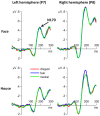Spatial attention effects of disgusted and fearful faces
- PMID: 24983360
- PMCID: PMC4077798
- DOI: 10.1371/journal.pone.0101608
Spatial attention effects of disgusted and fearful faces
Erratum in
- PLoS One. 2014;9(9):e107848
Abstract
Effective processing of threat-related stimuli is of significant evolutionary advantage. Given the intricate relationship between attention and the neural processing of threat-related emotions, this study manipulated attention allocation and emotional categories of threat-related stimuli as independent factors and investigated the time course of spatial-attention-modulated processing of disgusting and fearful stimuli. The participants were instructed to direct their attention either to the two vertical or to the two horizontal locations, where two faces and two houses would be presented. The task was to respond regarding the physical identity of the two stimuli at cued locations. Event-related potentials (ERP) evidences were found to support a two-stage model of attention-modulated processing of threat-related emotions. In the early processing stage, disgusted faces evoked larger P1 component at right occipital region despite the attention allocation while larger N170 component was elicited by fearful faces at right occipito-temporal region only when participants attended to houses. In the late processing stage, the amplitudes of the parietal P3 component enhanced for both disgusted and fearful facial expressions only when the attention was focused on faces. According to the results, we propose that the temporal dynamics of the emotion-by-attention interaction consist of two stages. The early stage is characterized by quick and specialized neural encoding of disgusting and fearful stimuli irrespective of voluntary attention allocation, indicating an automatic detection and perception of threat-related emotions. The late stage is represented by attention-gated separation between threat-related stimuli and neutral stimuli; the similar ERP pattern evoked by disgusted and fearful faces suggests a more generalized processing of threat-related emotions via top-down attentional modulation, based on which the defensive behavior in response to threat events is largely facilitated.
Conflict of interest statement
Figures





References
-
- Bishop SJ, Jenkins R, Lawrence AD (2007) Neural processing of fearful faces: effects of anxiety are gated by perceptual capacity limitations. Cerebral cortex 17: 1595–1603. - PubMed
-
- Holmes A, Vuilleumier P, Eimer M (2003) The processing of emotional facial expression is gated by spatial attention: evidence from event-related brain potentials. Cognitive Brain Research 16: 174–184. - PubMed
Publication types
MeSH terms
LinkOut - more resources
Full Text Sources
Other Literature Sources

